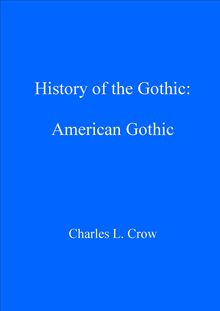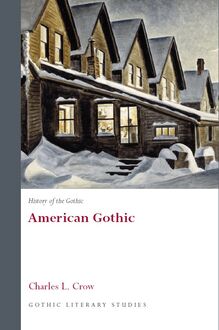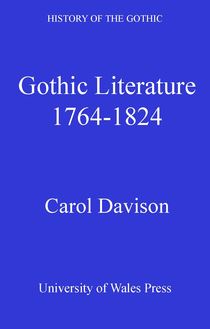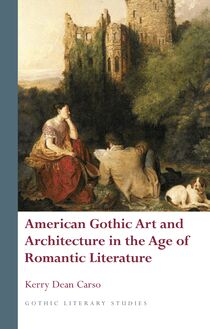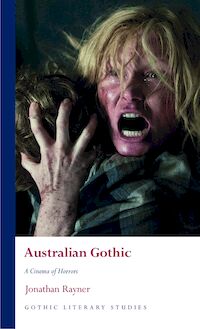History of the Gothic: Twentieth-Century Gothic , livre ebook
106
pages
English
Ebooks
2011
Vous pourrez modifier la taille du texte de cet ouvrage
Obtenez un accès à la bibliothèque pour le consulter en ligne En savoir plus
Découvre YouScribe en t'inscrivant gratuitement
Découvre YouScribe en t'inscrivant gratuitement
106
pages
English
Ebooks
2011
Vous pourrez modifier la taille du texte de cet ouvrage
Obtenez un accès à la bibliothèque pour le consulter en ligne En savoir plus
Publié par
Date de parution
15 janvier 2011
Nombre de lectures
1
EAN13
9781783164332
Langue
English
Poids de l'ouvrage
2 Mo
Provides an introduction to twentieth century Gothic fiction from Henry James to Sarah Waters. This title covers themes that include: the role of the ghost in relation to childhood and cultural mourning, the relationship between Gothic architecture and the 'landscapes' of dream and nightmare.
Publié par
Date de parution
15 janvier 2011
Nombre de lectures
1
EAN13
9781783164332
Langue
English
Poids de l'ouvrage
2 Mo
TWENTIETH-CENTURY GOTHIC
S ERIES P REFACE
Gothic Literary Studies is dedicated to publishing groundbreaking scholarship on Gothic in literature and film. The Gothic, which has been subjected to a variety of critical and theoretical approaches, is a form which plays an important role in our understanding of literary, intellectual and cultural histories. The series seeks to promote challenging and innovative approaches to Gothic which question any aspect of the Gothic tradition or perceived critical orthodoxy.
Volumes in the series explore how issues such as gender, religion, nation and sexuality have shaped our view of the Gothic tradition. Both academically rigorous and informed by the latest developments in critical theory, the series provides an important focus for scholastic developments in Gothic studies, literary studies, cultural studies and critical theory. The series will be of interest to students of all levels and to scholars and teachers of the Gothic and literary and cultural histories.
S ERIES E DITORS
Andrew Smith, University of Glamorgan
Benjamin F. Fisher, University of Mississippi
E DITORIAL B OARD
Kent Ljungquist, Worcester Polytechnic Institute Massachusetts
Richard Fusco, St Joseph s University, Philadelphia
David Punter, University of Bristol
Chris Baldick, University of London
Angela Wright, University of Sheffield
Jerrold E. Hogle, University of Arizona
HISTORY OF THE GOTHIC
Twentieth-Century Gothic
Lucie Armitt
Lucie Armitt, 2011
All rights reserved. No part of this book may be reproduced in any material form (including photocopying or storing it in any medium by electronic means and whether or not transiently or incidentally to some other use of this publication) without the written permission of the copyright owner. Applications for the copyright owner s written permission to reproduce any part of this publication should be addressed to the University of Wales Press, 10 Columbus Walk, Brigantine Place, Cardiff, CF10 4UP.
www.uwp.co.uk
British Library CIP Data
A catalogue record for this book is available from the British Library.
ISBN 978-0-7083-2007-5 (hardback) 978-0-7083-2043-3 (paperback)
e-ISBN 978-1-78316-433-2
The right of Lucie Armitt to be identified as author of this work has been asserted in accordance with sections 77 and 79 of the Copyright, Designs and Patents Act 1988.
The Others (2001) Moviestore Collection Ltd/Alamy
C ONTENTS
Series Editors Foreword
Acknowledgements
Chronology
Illustrations
Introduction
1 Gothic Pathologies: Haunted Children
2 Building Suspense: Architectural Gothic
3 Gothic Inhumanity
4 Queering the Gothic
5 Survey of Criticism
6 Conclusion: Thriller and Stranger
Notes
Annotated Bibliography
S ERIES E DITORS F OREWORD
The History of the Gothic series consists of four volumes: Gothic Literature 1764-1824 , Gothic Literature 1825-1914 , Twentieth-Century Gothic and American Gothic . The series provides a comprehensive introduction to the history of Gothic Literature and to a variety of critical and theoretical approaches. Volumes in the series also raise questions about how the Gothic canon has been received and seek to critically challenge, rather than simply reaffirm, commonplace perceptions of the Gothic tradition. Whilst intended as an introduction to the history of the Gothic they thus also provide a rigorous analysis of how that history has been developed and suggest ways in which it can be critically renegotiated.
The series will be of interest to students of all levels who are new to the Gothic and to scholars and teachers of the history of Gothic Literature. The series will also be of interest to students and scholars working more broadly within the areas of literary studies, cultural studies, and critical theory.
Andrew Smith, University of Glamorgan
Benjamin F. Fisher, University of Mississippi
A CKNOWLEDGEMENTS
More years ago than I care to remember, Nickianne Moody lent me two books, Joseph Grixti, Terrors of Uncertainty (London: Routledge, 1989), and James B.Twitchell, Dreadful Pleasures (New York: Oxford University Press, 1985). I enjoyed them so much I never got around to returning them; this is both to thank Nickianne for her generosity in setting me off on a path that ultimately resulted in this book and to offer a grovelling apology. Another important milestone in this journey was a kind invitation by Anna Powell, back in 1994, to speak at her day conference on the Gothic at Manchester Metropolitan University. It was to prove not only a day that marked my entry into the arena of Gothic criticism but one that sealed my personal happiness. I am more grateful to Anna than she knows.
Many thanks are due to Andrew Smith for inviting me to contribute this volume to the series . Professor David Punter has been a long-term mentor and support and I wish to acknowledge the importance of that here, along with my gratitude. I also wish to express my gratitude to colleagues at the University of Salford, especially Gaynor Bagnall, for her friendship in desperate and not so desperate times, and the irrepressible and inspirational Jane Kilby. Many thanks are due to colleagues in the Gender Reading Group at Salford, with whom I have shared a number of joyful and informative debates, and to Mike Freeman and Matt Mason for their technical support. I especially acknowledge the input of my students on Twenty-First-Century Women s Fiction at the University of Salford, particularly the class of 2008, in dialogue with whom I shaped my reading of The Thing in the Forest (see chapter 1). Specifically in relation to the intertexual connection between the ending of that story and Little Red Riding Hood , I would single out Lee Beales for particular acknowledgement.
Some of the work included in this volume has appeared previously in earlier or partial form. A section of the material on Fingersmith in chapter 4 is already published in Dark Departures: Contemporary Women s Writing after the Gothic in Benjamin A. Brabon and St phanie Genz (eds), Postfeminist Gothic: Critical Interventions in Contemporary Culture (Basingstoke: Palgrave Macmillan, 2007), pp.16-29. Some of the material on The Little Stranger appearing here in chapter 6, was published as Garden Paths and Blind Spots in New Welsh Review , 85 (2009). I am grateful to St phanie and Ben and to Kathryn Gray, Editor of New Welsh Review , for their kind permission to reproduce that material here. Co-writing (with Sarah Gamble) Haunted Geometries , published in Textual Practice in 2006, helped inform my subsequent understanding of architecture (especially the work of Escher and Piranesi) within a contemporary Gothic frame and has enabled the more recent developments of those ideas included here in chapter 2. I am grateful to Sarah for her collegial friendship, not to mention the kind donation of her copy of Steve Szilagyi s Photographing Fairies . Additionally, invited papers at University College London, the universities of Oxford, Hull, Edge Hill and Bolton, and at the Salford Film Seminar have enabled me to air some of these ideas with my peers. I here gratefully acknowledge the input of all who attended and participated in the resulting discussions and especially thank Nadine Muller, Matthew Gandy and Johan Anderssen, Ann Heilmann, St phanie Genz and Ben Brabon, David Rudd, Peter Buse and Andy Willis for their kind invitations.
All academic works of literary criticism rely on the close discussion of primary material and I am especially grateful to the following for permission to quote from these works: The Thing in the Forest , in Little Black Book of Stories by A. S. Byatt, published by Chatto & Windus. Reprinted by permission of The Random House Group Ltd., copyright 2003 A.S.Byatt. Reproduced by permission of the author c/o Rogers, Coleridge &White Ltd., 20 Powis Mews, London W11 1JN; The Name of the Rose , by Umberto Eco, translated by William Weaver, published by Secker and Warburg, reprinted by permission of The Random House Group Ltd; The Seventh Horse and Other Tales , by Leonora Carrington, published by Virago Press, an imprint of Little, Brown Book Group; The Wasp Factory , by Iain Banks, published by Abacus, an imprint of Little, Brown Book Group; The Angel and Dr Haggard s Disease , by Patrick McGrath, Gregory and Company Authors Agents, 3 Barb Mews, London W6 7PA; Fingersmith Sarah Waters 2002, The Night Watch Sarah Waters 2006, The Little Stranger Sarah Waters 2009.Reproduced by kind permission of Virago, an imprint of Little, Brown Book Group; The Birds , by Daphne Du Maurier, reproduced with permission of Curtis Brown Group Ltd London on behalf of the Chichester Partnership, copyright Daphne du Maurier 1952; The Hellbound Heart , by Clive Barker, copyright 1991 by Clive Barker, reprinted by permission of Harper Collins publishers. Sustained efforts have been made to trace copyright holders for all primary material discussed in this book, but it has not been possible to trace them in all cases. The author apologises for any resulting omission and requests that the copyright holder contact the publisher in any such case.
As ever, my wholehearted gratitude and devotion go to my children, Bethany and Rowan, for tolerance and understanding well beyond their years, and to Scott for coming to my paper at MMU all those years ago. The whole book is in dearest memory of my Mum, Jean Armitt, who died during its final stages.
C HRONOLOGY OF M AJOR W ORKS
1886
Robert Louis Stevenson publishes The Strange Case of Dr Jekyll and Mr Hyde , his first really successful book. Its influence is perhaps greater than any other on the twentieth-century Gothic.
1891
Oscar Wilde publishes The Picture of Dorian Gray ,a narrative which continues to exert an influence over Gothic narratives throughout the twentieth century, particularly, though not exclusively, those connected with homosocial and homosexual male characters.
1892
Charlotte Perkins Gilman


